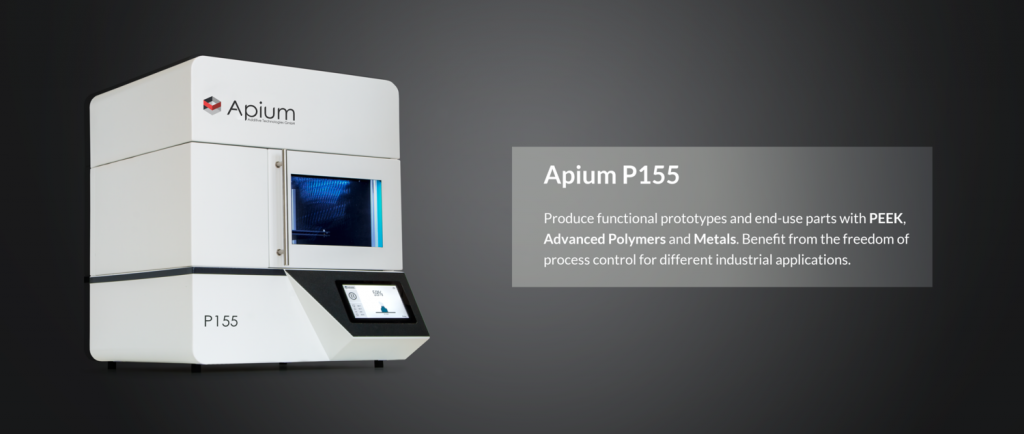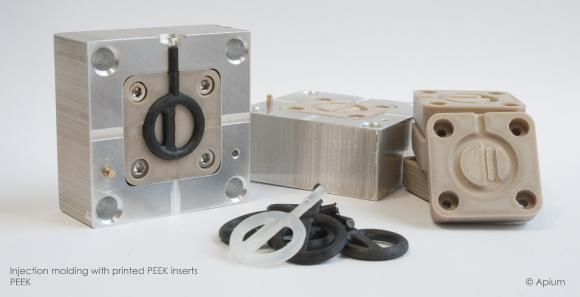3D Printing Industry is taking an in depth look at how additive manufacturing is moving to production. Over the coming weeks the results of interviews with industry leading practitioners will be published.
This article is part of a series examining Trends in Additive Manufacturing for End-Use Production.
Prof. Brando Okolo is Director and CTO at Apium Additive Technologies GmbH – Germany. Apium is based in Karlsruhe, Germany and is a leader in the use of high-grade thermoplastics such as PEEK for 3D printing.
3D Printing Industry: What is your percentage estimate of how much your printers are used for production versus other applications?
Prof. Brando Okolo: About 10-15 % of our sold printers are used for producing industrial parts. The rest of our printers is used for researching, testing and prototyping.

3DPI: Do you have an estimate of the addressable market for AM in production?
PBO: The actual production of parts using AM, compared to the whole value chain where AM is used, is quite small, covering only about 20%. Product development and prototyping have a relatively bigger share.
3DPI: Which industries or verticals are leading in the use of AM for production?
PBO: From our point of view there is no industry that is leading absolutely in the use of AM for production. There are different industries, like electronics, aerospace, chemical or medical that are using AM quite frequently.
However, education industry is quite important for us. There is a lot of effort coming from them using our printers for producing functional parts that they need for their research projects.

3DPI: What barriers does AM face for production and how are these surmountable?
PBO: Unfortunately there are still many barriers that we encounter while being in contact with companies in the field of production. The technical knowledge for AM is still lacking as information are not comprehensive enough.
We are still at that point where we are educating our customers. This also comes along with the lack of qualified labour. Another reason is, that AM in general is not yet developed to a state where it can be described as a “mature” technology as is today the case for already established manufacturing methods like injection moulding and CNC milling. These established manufacturing methods had also at some point gone through teething challenges; AM still needs some time to fully develop. That is also the reason why many companies hesitate to use AM for production, they compare it to fully developed processes, slowing down the progression of AM.
To a certain extent, costs are also a mitigating factor, conjuring hesitation in some businesses towards AM. For instance, AM cannot compete with processes like injection moulding in terms of the cost of a part in mass production.
However, AM, and in particular our Fused Filament Fabrication technology, can compete very well for smaller batches and individual parts. For AM to make it as a mainstream industrial manufacturing method, companies have to rethink their production philosophy, exercising openness towards new ideas in terms of design and processes. AM is working in the university and R&D fields because the space for trial and error is much greater.

3DPI: Are there any notable trends in AM for end use production?
PBO: Over the last few months there are two big trends ongoing in the field of AM.
The first is in the medical sector. We believe that there a lot of potential to have AM as an established implant manufacturing tool in medical practice.
The second big trend is in the area of metals processing. In recent times there has been a lot of development work and investment interest taking place in this field. Clearly, metals are still the most desired material for production. Apium is also making a lot strategic driven work in these trending aspects of AM.
3DPI: Can you name any specific case studies where AM is used for end use production?
PBO: In the most recent time we printed mold inserts made from the high temperature polymer PEEK for injection moulding application. The end-user company collaborating with us on this topic used the 3D printed mold insert for functional parts deployed to the commercial market space.
The 3D printed mould insert had a 4 days delivery time from order compared to 90 days for the previously used aluminium version. In terms of cost the 3D printed PEEK mold insert cost about 100 times less than the metallic version.
3DPI: Is there is anything else you’d like to highlight in this area?
PBO: As already alluded to above, one of the most important tasks facing custodians of AM technologies is to educate industrialists on best practices for good AM adoption. I firmly believe that a fundamental approach to this task begins in our educational institutions; high schools and universities. For instance, we need lecture modules and study programs fully dedicated to AM. This way we are able to now prepare the qualified labour force needed to drive our industries to the future; Industry 4.0. Also, the companies exploring adoption of AM need to make it possible for their workforce to receive the extra training required for implementation of AM.
Nominations for the 2018 3D Printing Industry Awards are now open. Let us know who is leading the industry.
For more information about Apium Additive Technologies GmbH is available here.
This article is part of a series examining Trends in Additive Manufacturing for End-Use Production.
If you found this insight useful, then subscribe to our newsletter and follow us on social media.


